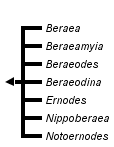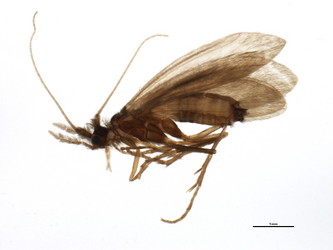Beraeidae
Karl Kjer


This tree diagram shows the relationships between several groups of organisms.
The root of the current tree connects the organisms featured in this tree to their containing group and the rest of the Tree of Life. The basal branching point in the tree represents the ancestor of the other groups in the tree. This ancestor diversified over time into several descendent subgroups, which are represented as internal nodes and terminal taxa to the right.

You can click on the root to travel down the Tree of Life all the way to the root of all Life, and you can click on the names of descendent subgroups to travel up the Tree of Life all the way to individual species.
For more information on ToL tree formatting, please see Interpreting the Tree or Classification. To learn more about phylogenetic trees, please visit our Phylogenetic Biology pages.
close boxIntroduction
This small family, established by Wallengren (1891), is comprised of 7 genera and about 50 species. It reaches its greatest diversity in the western Palearctic region, where 5 genera occur (Beraea Stephens, Beraeamyia Mosely, Ernodes Wallengren, Beraeodes Eaton, and Beraeodina Mosely, the latter 2 monotypic). The genus Beraea also occurs in eastern North America, where 3 species are known. A single genus, Notoernodes, with 2 species, occurs in Tanzania. Elsewhere the family is found only in Japan, where it is represented by the genus, Nippoberaea Botosaneanu, Nozaki, & Kagaya, containing a single species, N. gracilis (Nozaki & Kagaya). Gut contents of Beraea gorteba Ross in southeastern North America included small pieces of vascular plants, fungal mycelia, and other organic material, but no animal parts (Hamilton 1985), foodstuffs probably typical of most species in the family. From Holzenthal et al. (2007).Characteristics
Most beraeid larvae build slightly to strongly tapered cases of small sand grains and live in springs, seeps, and small streams, usually among aquatic mosses, leaf litter deposits, roots of emergent plants, and other dense, marginal vegetation or in the marginal organic sediments (Hamilton 1985). From Holzenthal et al. (2007).References
Hamilton, S.W. (1985) The larva and pupa of Beraea gorteba Ross (Trichoptera: Beraeidae). Proceedings of the Entomological Society of Washington, 87, 783–789.
Holzenthal R.W., Blahnik, R.J., Prather, A.L., and Kjer K.M. 2007. Order Trichoptera Kirby 1813 (Insecta), Caddisflies. In: Zhang, Z.-Q., and Shear, W.A. (Eds). 2007 Linneaus Tercentenary: Progress in Invertebrate Taxonomy. Zootaxa. 58 pp. 1668:639-698
Wallengren, H.D.J. (1891) Skandinaviens Neuroptera. Andra afdelningen. Svenska Akademien Handlingar, 24, 1–173.
Title Illustrations

| Scientific Name | Beraea maura |
|---|---|
| Location | Piedmont, Italy |
| Creator | Karl Kjer |
| Identified By | Hans Malicky |
| Life Cycle Stage | Adult |
| View | Lateral |
| Collector | G.B. Delmastro & M. Evangelista |
| Source Collection | Barcode of Life Database (BOLD) |
About This Page
Karl Kjer

Rutgers University, New Brunswick, New Jersey, USA
Correspondence regarding this page should be directed to Karl Kjer at
Page copyright © 2010 Karl Kjer
 Page: Tree of Life
Beraeidae.
Authored by
Karl Kjer.
The TEXT of this page is licensed under the
Creative Commons Attribution-NonCommercial License - Version 3.0. Note that images and other media
featured on this page are each governed by their own license, and they may or may not be available
for reuse. Click on an image or a media link to access the media data window, which provides the
relevant licensing information. For the general terms and conditions of ToL material reuse and
redistribution, please see the Tree of Life Copyright
Policies.
Page: Tree of Life
Beraeidae.
Authored by
Karl Kjer.
The TEXT of this page is licensed under the
Creative Commons Attribution-NonCommercial License - Version 3.0. Note that images and other media
featured on this page are each governed by their own license, and they may or may not be available
for reuse. Click on an image or a media link to access the media data window, which provides the
relevant licensing information. For the general terms and conditions of ToL material reuse and
redistribution, please see the Tree of Life Copyright
Policies.
- First online 17 July 2010
- Content changed 20 July 2010
Citing this page:
Kjer, Karl. 2010. Beraeidae. Version 20 July 2010 (under construction). http://tolweb.org/Beraeidae/14647/2010.07.20 in The Tree of Life Web Project, http://tolweb.org/







 Go to quick links
Go to quick search
Go to navigation for this section of the ToL site
Go to detailed links for the ToL site
Go to quick links
Go to quick search
Go to navigation for this section of the ToL site
Go to detailed links for the ToL site